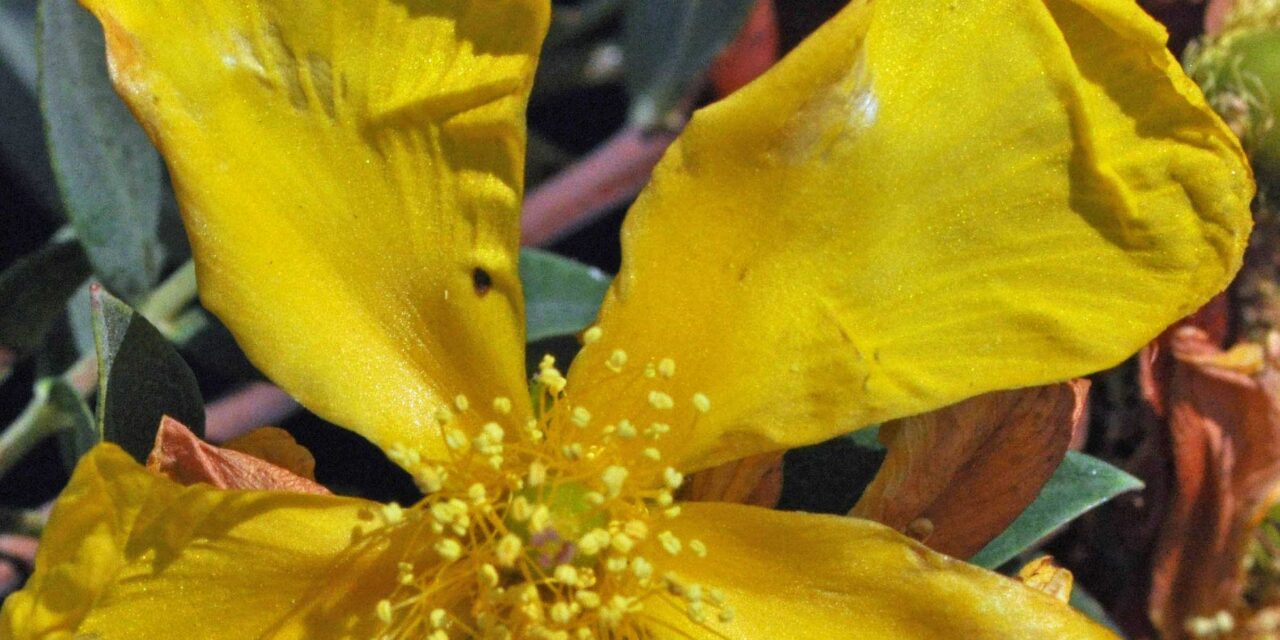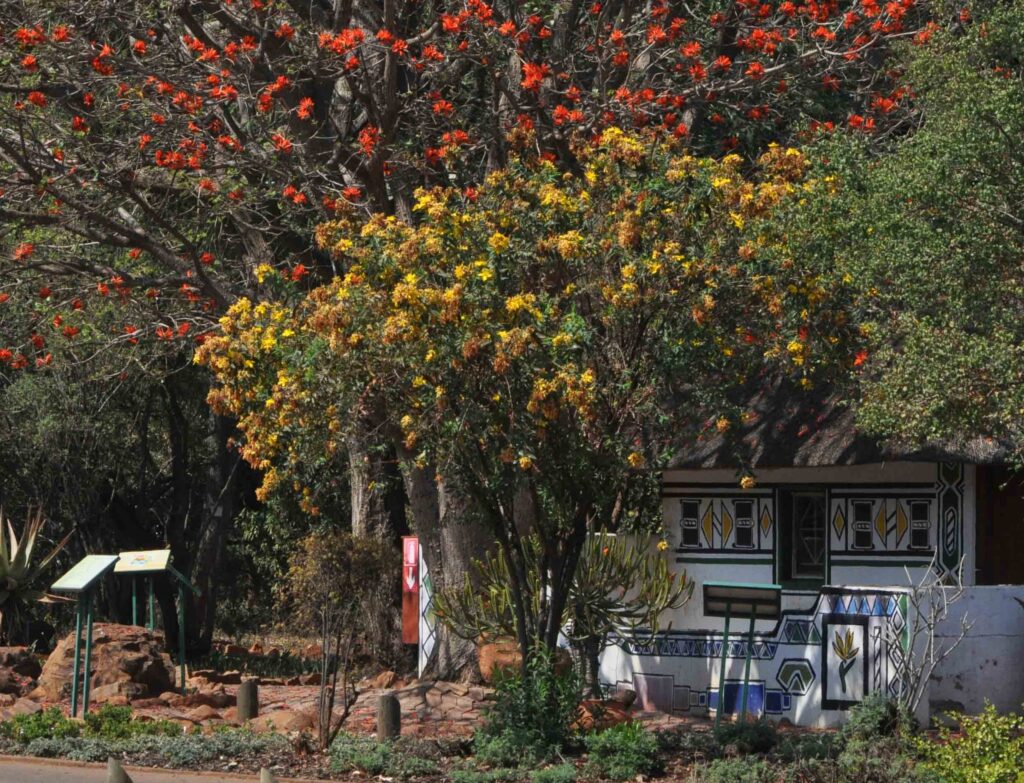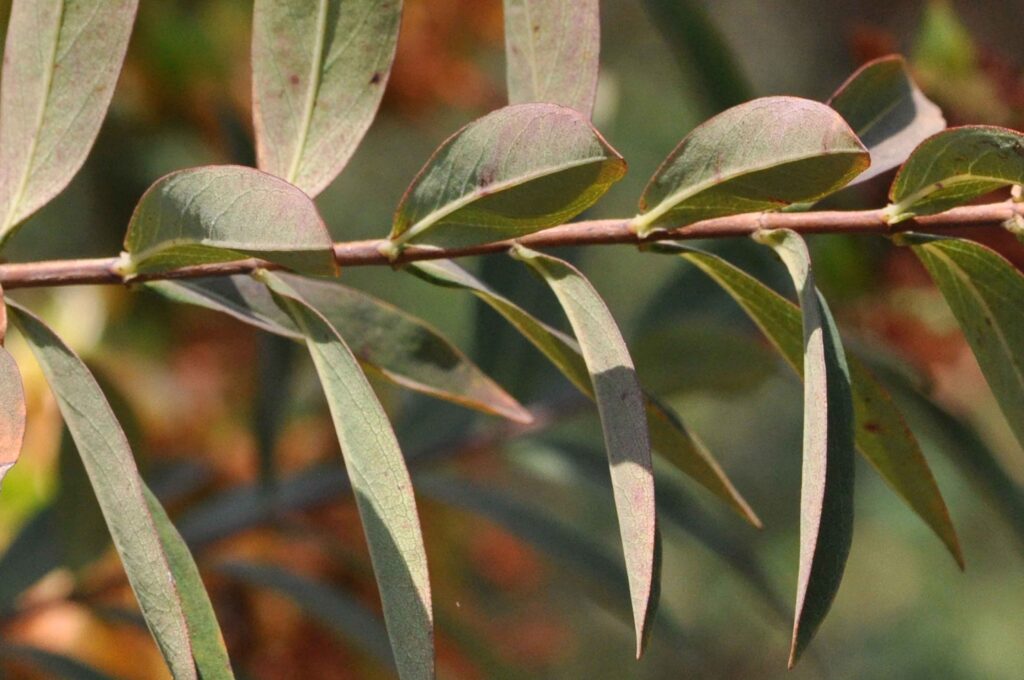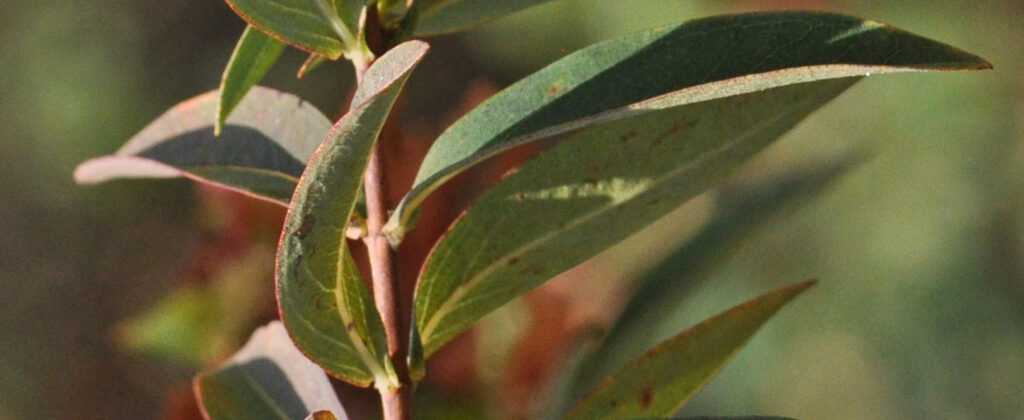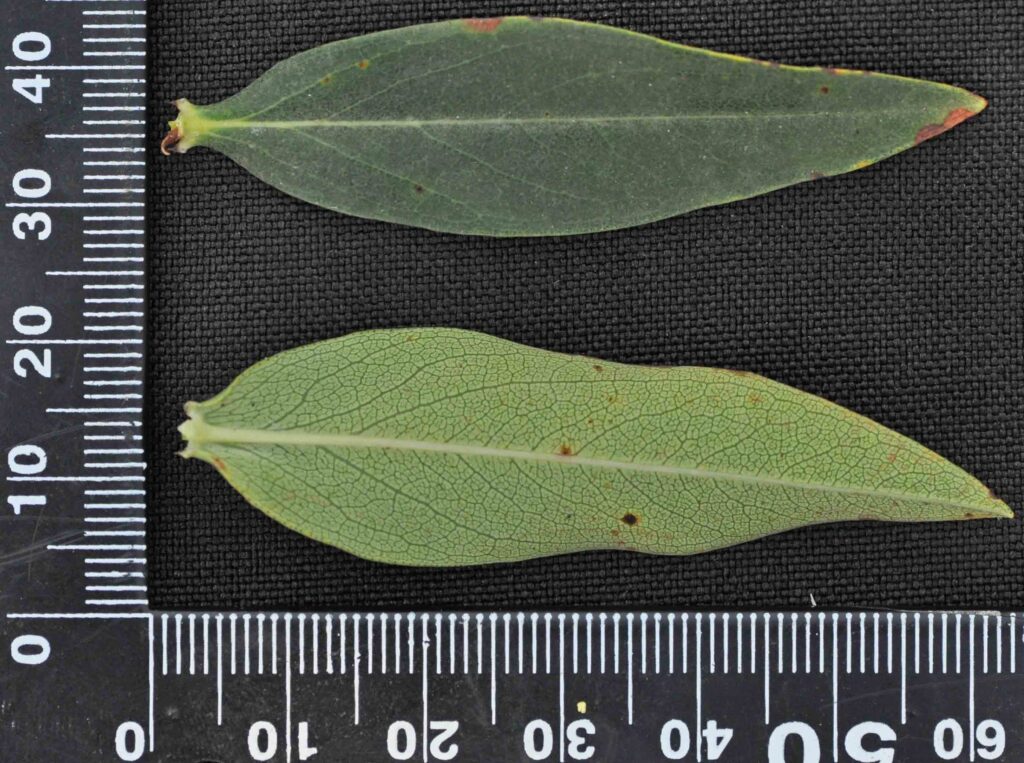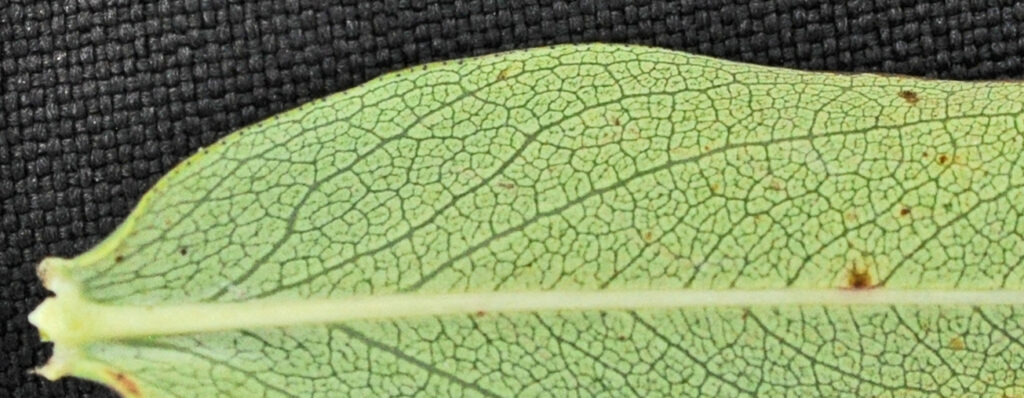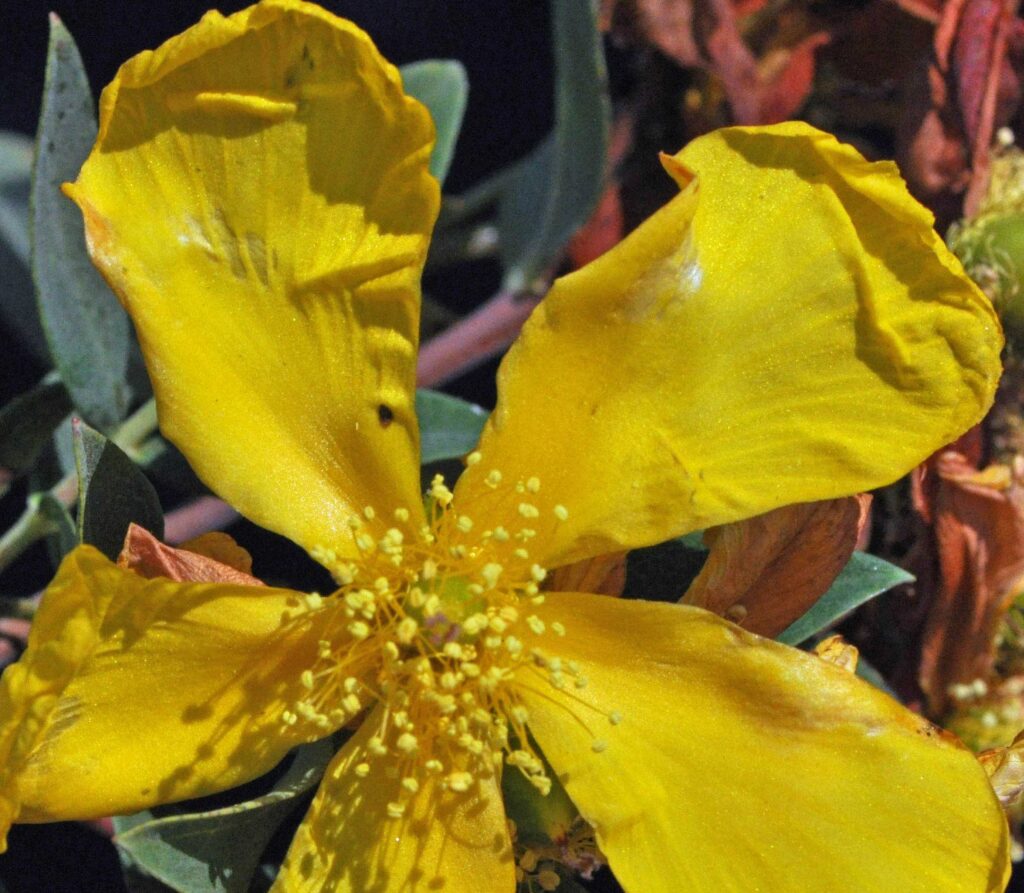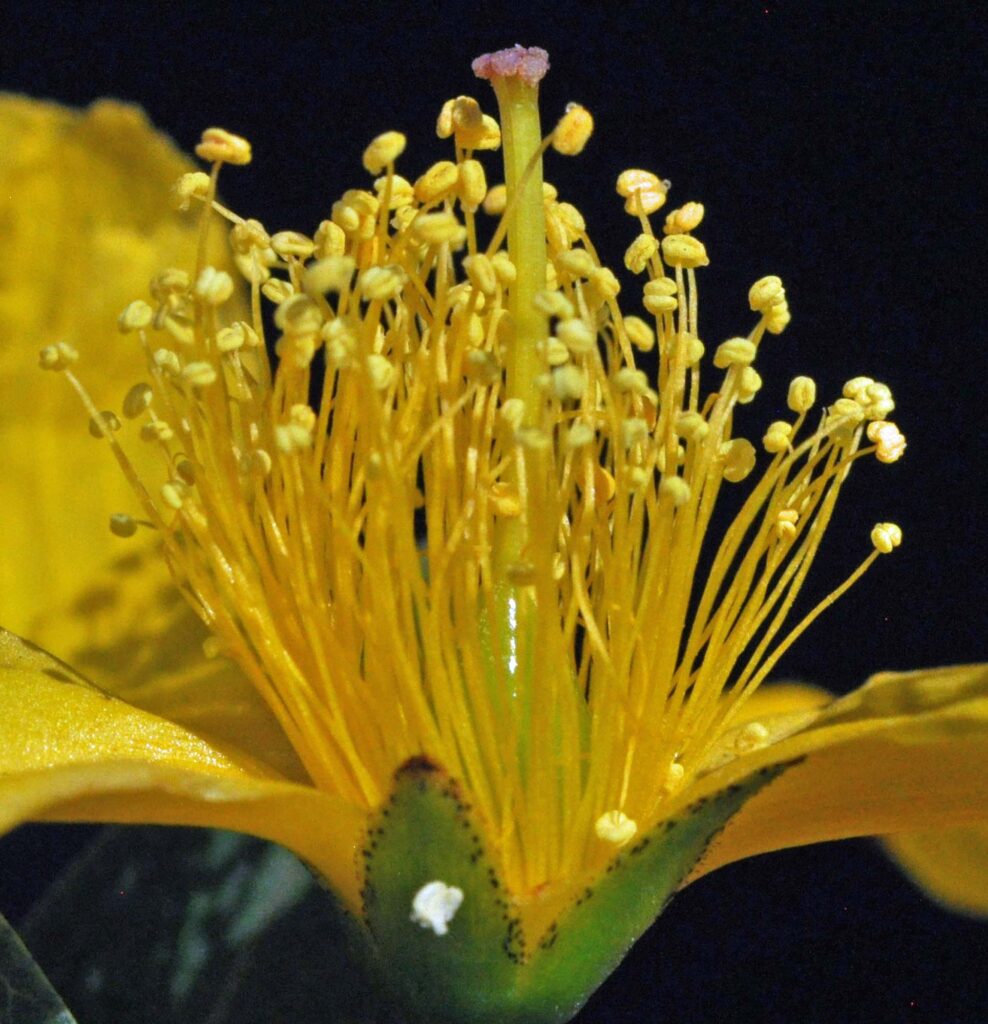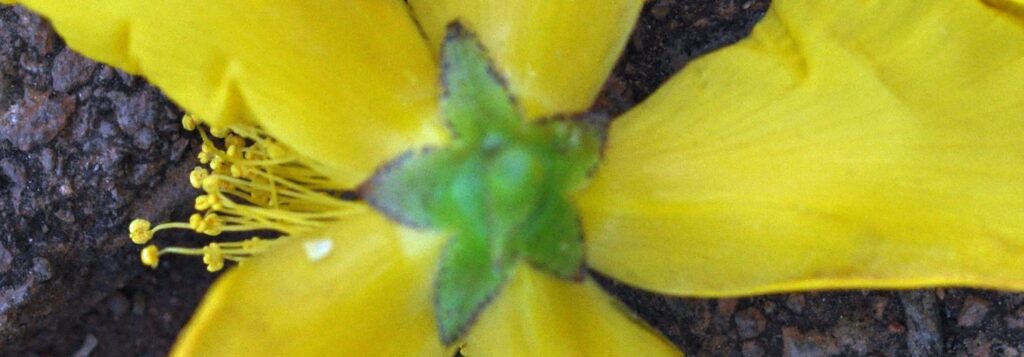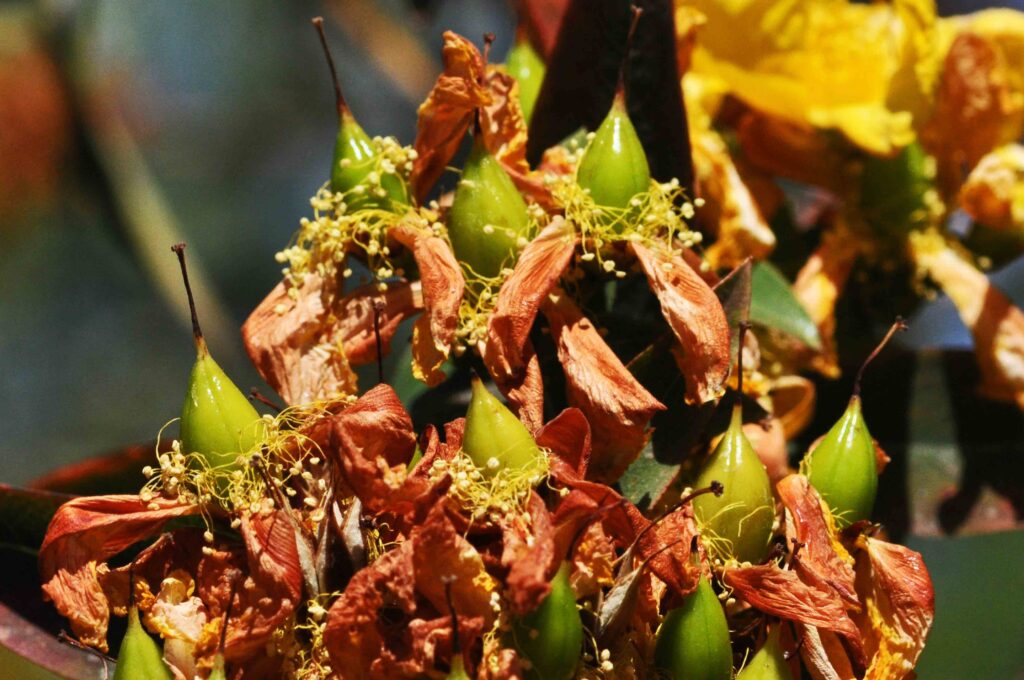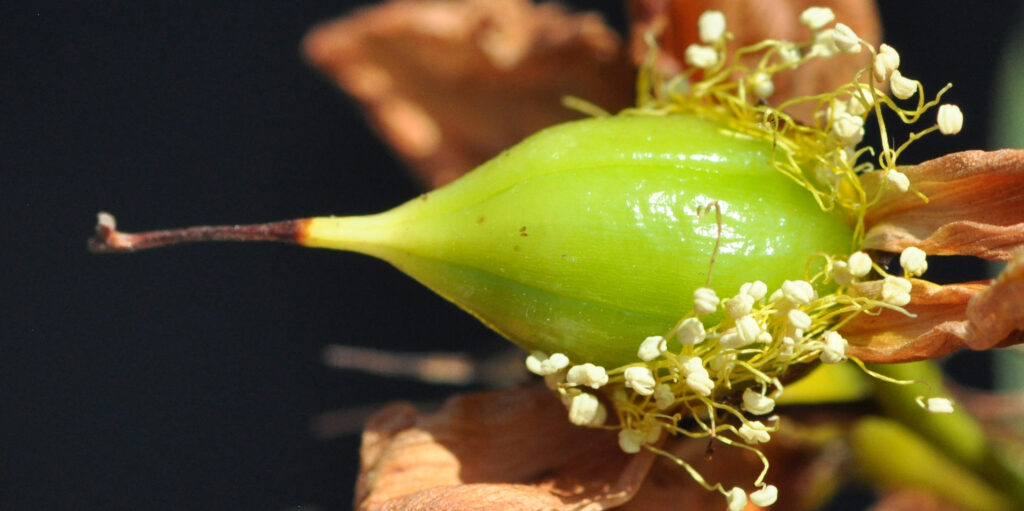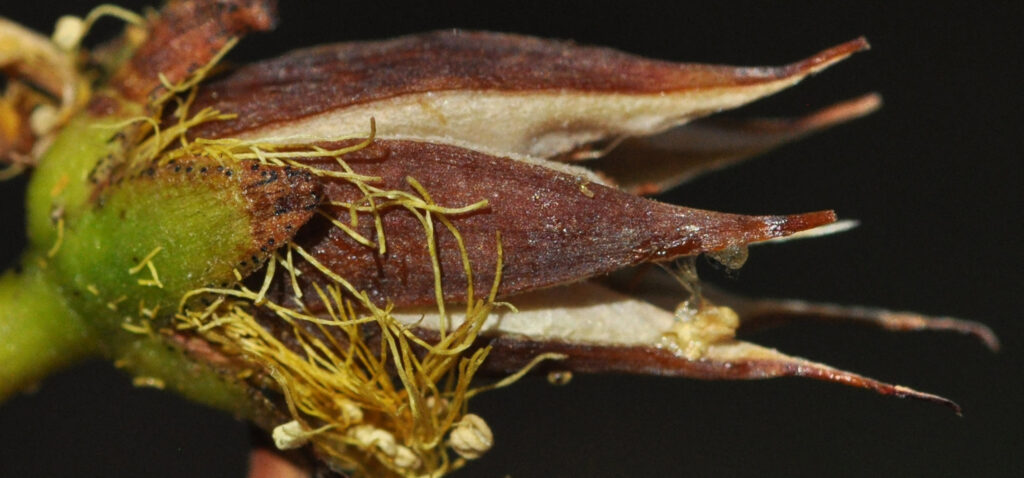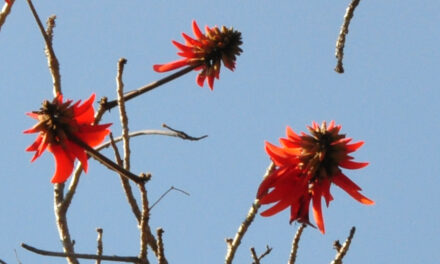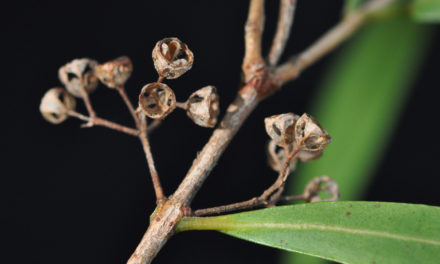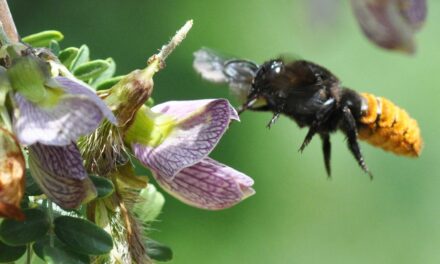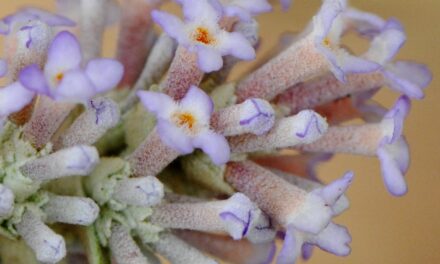General Info – summary
This thickly branched, monoecious Tree, with fissured bark, may reach 5m high. The simple, decussate, evergreen, and widely spaced Leaves have decurrent leaf bases and lack stipules. Bisexual, 5-merous and regular Flowers have green sepals and large yellow petals. Many yellow stamens surround the sessile superior ovary with its united styles extending the stigmas. Fruit is a capsule with small, ribbed seeds.
Description
Hypericum roeperianum var. roeperianum
Previous Names: Hypericum quartiniarum.
SA Tree No. 484.1
Common names: (Afr) Grootblaarkerriebos. (Eng) Large-leaved Curry-bush.
Family: Hypericaceae (St. John’s Wort family). This family has up to 9 genera and 700 species – mainly in the northern hemisphere. The Leaves are simple, entire and in opposite pairs with interpetiolar scars. The actinomorphic Flowers are 4 0r 5 merous. Petals are usually yellow. Many Stamens occur on long Filaments. The superior Ovary with 3-5 joined Styles which may be fused at the base. The Fruit is a capsule, which dehisces through the split capsule releasing the small black Seeds.
Name derivation: Hypericum. The Greek word for St John’s Wort (Hypericum perforatum) in the same family, which has flowers that are similar to Hypericum roeperianum. roeperianum – named after a German botanist Johannes August Christian Roeper (1801-1885). There are 10 species in southern Africa and only var. roeperianum occurs in southern Africa. In South Africa, these are mainly confined to the eastern side.
Conservation: National Status: L C. – Least Concern. Assessor: D. Pillay. (2005).
Tree
This is a thickly branched shrub or small Tree that may reach 5m high. The branchlets are reddish brown and almost square (photo 425 – under Leaves). The mature Bark is fissured, resulting in rough almost rectangular pieces (photo 424). Between these pieces, the reddish underbark is visible (photo 423).
- 421. 2019/08/29. Pretoria NBG. Photo David Becking.
- 424. 2019/08/29. Pretoria NBG. Photo David Becking.
- 423. 2019/08/29. Pretoria NBG. Photo David Becking.
Leaves
The aromatic, hairless and lanceolate to elliptic and sessile Leaves are relatively large – up to 8 x 3cm. They are opposite and decussate (the opposite pairs of leaves have successive pairs at right angles to each other i.e. rotated 90 degrees along the stem (photo 425) when viewed from above. Here an interpetiolar scar is present (photo 425R). Leaves are widely spaced along the stem. The Petiole (leaf stalk) is absent and the leaf Base is narrowly tapering and is decurrent (leaf blades that partly wrap or have wings around the stem or petiole – photo 430R). The Apex is narrowly tapering. The rolled under, pale green Margin is entire (with a continuous margin, not in any way indented). Sub-marginal dark glandular dots are present (430R). These are visible when the leaf is examined against a strong light. In addition to this, translucent minute oil glands are present. The Midrib reaches the leaf apex (photo 425) and is clearly visible on both sides but only protrudes below (photo 430). On the lower, lighter green surface, the Veins are clearly visible (photo 430). The upper leaf surface is darker. Stipules (basal appendages of the petiole) are absent.
- 425. 2019/08/29. Pretoria NBG. Photo David Becking.
- 425R. 2019/08/29. Pretoria NBG. Photo David Becking.
- 430. 2019/08/29. Pretoria NBG. Photo David Becking.
- 430R. 2019/08/29. Pretoria NBG. Photo David Becking.
Flowers
This plant is monoecious (having both male and female reproductive organs on the same plant). Individual bisexual, aromatic and 5-merous Flowers are up to 5cm in diameter, arise at the ends of branches and are actinomorphic (Regular, symmetrical. Flowers are vertically divisible into similar halves by more than 1 plane passing through the axis). The attractive bright yellow flowers appear in numbers mainly in early spring (intro photo). The lobes of the 5 green Sepals alternate with the yellow petals (photo 58) and sub-marginal dark dots are present (photo 427). The 5 Petals are asymmetric. There is a conspicuous mass of initially yellow Stamens present. The yellow delicate Filaments are thread-like and terminate in the initially yellow Anthers (photo 427). The ovoid sessile superior Ovary has at least 3 united Styles which elevate the purplish lobed Stigmas slightly beyond the stamens (photo 427).
- 426. 2019/08/29. Pretoria NBG. Photo David Becking.
- 427. 019/08/29. Pretoria NBG. Photo David Becking.
- 58. 2019/09/12. Pretoria NBG. Photo David Becking.
Fruit
The Fruit is a dry pyramidal Capsule (a dry fruit resulting from the maturing of a compound ovary which in this case dehisces at maturity between the carpels) that is up to 12 x 8mm. Photo 59 shows a number of fruit. Each individual fruit terminates with the remains of a persistent Style (photo 428). Here old, now white anthers are visible for a short while as are the wrinkled filaments. The fruit is apically dehiscent (photo 224). Here the now shrinking filaments and white anthers are visible (photo 428). The minute ribbed Seeds have a thin testa (seed coat).
- 59. 2019/09/12. Pretoria NBG. Photo David Becking.
- 428. 2019/08/29. Pretoria NBG. Photo David Becking.
- 224. 2019/10/08. Pretoria NBG. Photo David Becking.
Distribution & Ecology
These plants only naturally occur in Limpopo in South Africa. They also are found in the central and eastern highlands of Zimbabwe, east-central Mozambique and northwards to Ethiopia and Sudan. This aromatic plant occurs in evergreen forest margins, bushland, besides streams and in moist bamboo thickets. They also occur in woodlands, dry, moist and even wet areas. They are common between montane grasslands and evergreen forests. When flowering this very eye-catching plant attracts both insects and birds. At least 3 of the 4 bright yellow butterflies in the genus Eurema produce larvae that feed on this plant. Large numbers of these plants act like a firebreak to other plants. This plant is most numerous within the 1 100 – 1 800m altitude range.
Ethnobotany
Seeds, cuttings or runners are used for propagation. Parts are used in local medicine. This plant contains Hypericin – like substances – that are believed to act as an antibiotic, antiviral and non-specific kinase inhibitor – used in some cancer treatments. From early times, this genus has been thought to have powers over black magic and lightning. It has also been used to cure melancholia and insanity. Some believed that the glandular dots, peculiar to leaves of these plants, were made by the devil in an attempt to destroy their powers.
References
Burrows, J.E., Burrows, S.M., Lotter, M.C. & Schmidt, E. Trees and Shrubs Mozambique. Publishing Print Matters (Pty) Ltd. Noordhoek, Cape Town.
Coates Palgrave, M. 2002. Keith Coates Palgrave Trees of Southern Africa, edn 3. Struik, Cape Town.
Palmer, E. & Pitman, N. 1972. Trees of southern Africa. Balkema, Amsterdam, Cape Town.
Pillay, D. 2005. Hypericum roeperianum G.W.Schimp. ex A.Rich. var. roeperianum. National Assessment: Red List of South African Plants version 2020.1. Accessed on 2023/07/20.
Schmidt, S. Lotter, M. & McCleland, W. 2002. Trees and Shrubs of Mpumalanga and the Kruger National Park. Jacana, Johannesburg.
van Wyk, B. & van Wyk, P. 1997 Field guide to Trees of Southern Africa. Struik, Cape Town.
https://www.wikidata.org/wiki/Q4402838
https://www.zimbabweflora.co.zw/speciesdata/species.php?species_id=140390
http://old.worldagroforestry.org/usefultrees/pdflib/Hypericum_roeperianum_ETH.pdf
https://en.wikipedia.org/wiki/Hypericaceae
https://en.wikipedia.org/wiki/Hypericin
Thanks to the staff at Pretoria NBG for help with ID.

